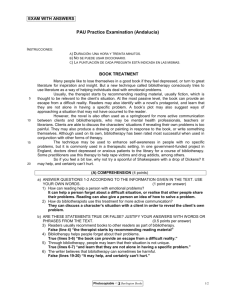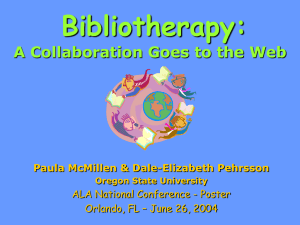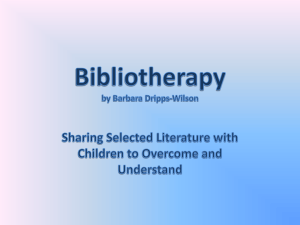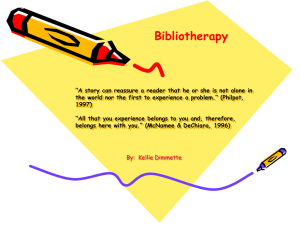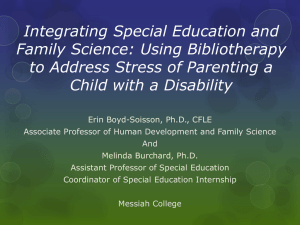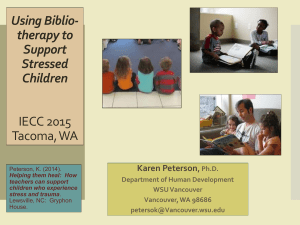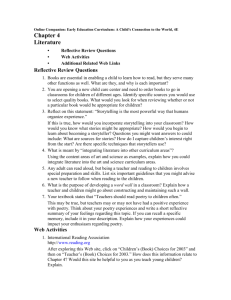Book buddies: Nurture and culture, reading habits among paediatric
advertisement
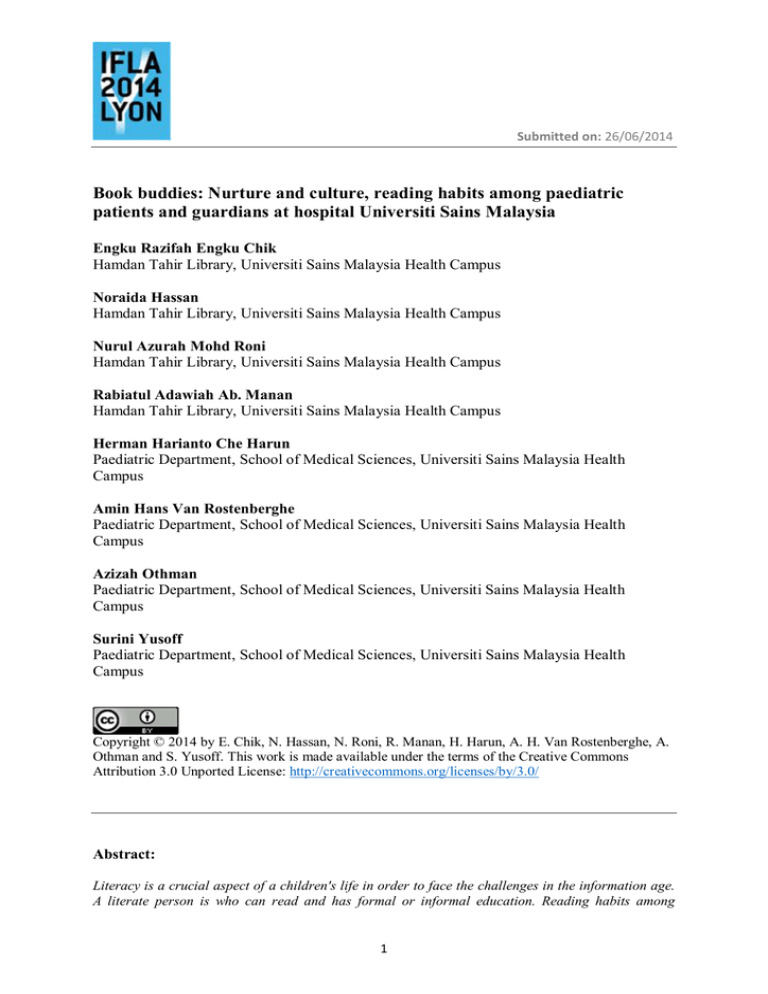
Submitted on: 26/06/2014 Book buddies: Nurture and culture, reading habits among paediatric patients and guardians at hospital Universiti Sains Malaysia Engku Razifah Engku Chik Hamdan Tahir Library, Universiti Sains Malaysia Health Campus Noraida Hassan Hamdan Tahir Library, Universiti Sains Malaysia Health Campus Nurul Azurah Mohd Roni Hamdan Tahir Library, Universiti Sains Malaysia Health Campus Rabiatul Adawiah Ab. Manan Hamdan Tahir Library, Universiti Sains Malaysia Health Campus Herman Harianto Che Harun Paediatric Department, School of Medical Sciences, Universiti Sains Malaysia Health Campus Amin Hans Van Rostenberghe Paediatric Department, School of Medical Sciences, Universiti Sains Malaysia Health Campus Azizah Othman Paediatric Department, School of Medical Sciences, Universiti Sains Malaysia Health Campus Surini Yusoff Paediatric Department, School of Medical Sciences, Universiti Sains Malaysia Health Campus Copyright © 2014 by E. Chik, N. Hassan, N. Roni, R. Manan, H. Harun, A. H. Van Rostenberghe, A. Othman and S. Yusoff. This work is made available under the terms of the Creative Commons Attribution 3.0 Unported License: http://creativecommons.org/licenses/by/3.0/ Abstract: Literacy is a crucial aspect of a children's life in order to face the challenges in the information age. A literate person is who can read and has formal or informal education. Reading habits among 1 children is hard to cultivate especially when it’s related to healthcare condition. One of the solutions to culture reading habits among paediatric patients is via bibliotherapy technique. Bibliotherapy in treating paediatric and adult patients has been long implemented in overseas. This method involves using books or reading materials to help with solving problems and coping with life changes. Hamdan Tahir Library has taken the initiative with the Book Buddies Project using bibliotherapy with paediatric patients at Hospital Universiti Sains Malaysia (USM). The objectives of this project are to boost the motivation and psychology of the patients and their guardians, to instil reading habits in youngsters as well as adults and to increase the awareness about the importance of reading and library in the community. The children’s mind can be moulded through their participation in the activities held by the Library. This project has also strengthened volunteerism spirit among the library staff indirectly. The methodologies employed in this project are observation, discussion and involvement in activities. Selected reading materials and delivery of activities were based on patients’ condition. Moral support from all parties is needed to relieve pressure and pain among the young patients. This project has given the library an opportunity to expand its services at the hospital as well as nurturing compassion towards the needy group. A mobile library service will be introduced in an upcoming project as an extended of library services to paediatric patients and guardian. The contribution of library and librarians in community service can be a good way to build university reputation and create a multitasking environment among staff. Keywords: Bibliotherapy, Community Service, Paediatric Patients, Library 1. Introduction The library has been a resource centre and information reference for all segments of society. The role of libraries in the era of globalization is not only limited to the tasks related to reference services, circulation (loans and returns) and the only source of revenue. The diversity of the work carried out by librarians nowadays has become a contributing factor towards the recognition of careers in librarianship worldwide and in Malaysia in particular. The direct involvement of Academic libraries in academic and research activities has given these libraries a great opportunity to serve their surrounding communities. The Universiti Sains Malaysia (USM) hospital as a teaching and learning centre has an advantage, because it is the focal point where people from various walks of life from infancy to old age, seek treatment and medical advice. Thus, the Hamdan Tahir Library has taken the initiative to participate in giving and contributing to paediatric patients (children) who are undergoing treatment at the USM hospital. Children and young people need to be nurtured and guided to form the next generation. Using the diversity of resources available in the library, bibliotherapy methods have been applied to cultivate a reading habit from an early age. This treatment method has been practiced abroad in treating patients and involves counsellors, psychologists and nurses. According Gubert (1993), Sadie Peterson Delaney was the first librarian who was able to use bibliotherapy in helping recovering mentally ill patients at the Veterans Administration Hospital in Tuskegee, Alabama. The intervention by librarians described in this paper demonstrates opportunities to enhance the role of librarians and change society's perception of career in librarianships. Indirectly, guardians also benefit from the services introduced. 2. Background to the study In essence, the Department of Paediatrics, School of Medical Sciences, USM Health Campus has implemented a weekly activity called “Riang Ria Rabu” (Wonderful Wednesday) that aims to provide psychosocial support to children in the hospital. The program is facilitated 2 mainly by medical students who have their paediatric posting at the department. Additionally, interested volunteers are also encouraged to participate and help facilitate the program. In response to the university’s aim to expand its community outreach programs, library management has taken the initiative to participate in the project by setting up a team of volunteers to carry out activities in the Children's Resource Centre, USM hospital according to a schedule which started in 2010. A storytelling segment with children was a major activity, followed by a segment of colouring, solving jigsaw puzzles, origami and so on. This voluntary activity proved beneficial and had a positive impact on the department and patients, so management applied for a grant from the Division of Industry and Community Network, USM to ensure the further success of this project. These grants were used to finance the acquisition of books, toys, gifts and stationery. This was encouraging and showed appreciation to the children who contributed ideas and actively participated in all sessions. In addition, the project also received the cooperation and contribution of Mattel Shared Service Solutions Pt. Limited., the Institut Terjemahan dan Buku Malaysia (ITBM), and Koperasi USM Berhad. Donated books and toys were stored in the resource centre and which gave pleasure to the child patients. When using the resources, illness suffered by the patients is minimized for a while. The paediatric patients involved in the project were from various ethnicities, religions, level of education, and family backgrounds. Due to distance from their residential areas and the need for continuous treatment, patients and their carers need to stay in hospital for set periods of time. Time spent at the hospital during convalescence needs to be filled with useful things such as reading books and watching educational videos clips. The adult guardians played an active role in the selection of reading materials to suit patients’ interests and reading levels. In addition, guardians also had the opportunity to access reading materials such as magazines, novels and motivational books for themselves. Passing time in hospital can be leveraged through reading together and even strengthen family ties between the patients and their guardians. In essence, with the bustle of taking care of the sick child, the carer has no chance to get access to reading materials and enough time to read. Therefore, this service assisted both patients and guardians to cultivate the habit of reading without limitations. According to records in 2013, a total of 78 paediatric patients from ages 1 to 12 years and their guardians have participated in this project. Positive feedback has been received from various parties comprising the guardians, caregivers, nurses and hospitals. 3. Bibliotherapy Bibliotherapy comes from the words biblion which means books or reading material and therapeia which means healing. As stated by Brewster (2009), bibliotherapy is the use of reading materials to restore the physical and mental health of the patients through reading, conversation and good understanding. According to Roselina and Mohd Shukry (2008), the word bibliotherapy means techniques used in a structured interaction between nurses and patients (whether individually or in a group) by the consortium of reading something to fulfill the purpose of giving treatment to the patients to resolve the problem or situation. Duffy et. al. (2009) also link bibliotherapy with reading books, stories and poems creatively, so that the patients can nurture positive feelings about themselves and others. This project focused on a guided reading program designed to improve the understanding of the patients about themselves and also to diversify their emotional experience. Through 3 reading, patients would be inspired, be more positive and eager. Following the Islamic perspective, the bibliotherapy method has long been practiced since it was introduced by the first revelation where a call regarding reading was received, as recorded in the chapter of Al 'Alaq verse 1-5. Categories of bibliotherapy According to Janaviciene (2010), bibliotherapy is divided into three categories based on the different objectives of the bibliotherapy process, the location of the application and also the professionals such as doctors, social workers, librarians, psychologists, teachers and others who implement the method. The three categories are clinical bibliotherapy, rehabilitation bibliotherapy, and educational bibliotherapy (personality development). Clinical bibliotherapy is directly related to the treatment of disease as conducted by a doctor. The objective is to treat the illness by providing reading materials which can have an impact on the patient. Reading materials can only be recommended and prescribed by the doctors who treat the patients. Bibliotherapy can only be implemented clinically in medical institutions and librarians can only serve as a member of the team. Rehabilitation bibliotherapy is different and includes recovery clinical bibliotherapy. This therapy is not used to treat disease, but rather to help overcome and also to help patients adapt to the changing environment. Its main purpose is to provide hope through reading materials which can show how others cope with and manage similar situations. Through this therapy, patients are able to expand their view and develop more positive expectations. Rehabilitation bibliotherapy can be provided and maintained by librarians in collaboration with medical staff. In this case, the library can collaborate with other units such as rehabilitation, day-care and social workers. Educational bibliotherapy is used by many social institutions and it is also closely associated with rehabilitation bibliotherapy because it involves personality development and adaptation to the changing environment. Through this therapy, patients may develop a more balanced personality and creativity. Professionals involved in this type of therapy are those who provide social services and include teachers, counsellors, social workers, librarians, and others. Bibliotherapy process According to Pardeck (1994 cited in Strub 2011) the bibliotherapy process or implementation comprises of four main steps. These are identifying the problems, the selection of reading materials, reading the selected materials and follow-up activity after the reading activity. The aspect of the implementation process involves identifying the problem to facilitate the therapeutic process. The problem can be identified through interviews and conversations. Once the problem is identified, the reading material should be selected so that it is consistent and coincides with the patients’ scenario. In this situation, librarians play a major role since it is their field of expertise. The third process involves reading the reading material. According to Foss (2009), a child is not required to read the material, but should they choose to participate, they naturally choose two or three selected reading materials or are read to by the volunteers. The final stage is the assessment after reading to identify whether the reading has had a positive impact on the patient. 4 Methods of bibliotherapy There are various methods that can be used in the implementation of bibliotherapy. The most conventional way is the use of novels, short stories, fairy tales, sagas and illustrated books. Such literature may be of interest and have positive impacts on children. Some examples of the titles that are often used are Chicken soup for the soul, A friend like Simon: A story about Autism, Little tree: A story for children with serious medical problems, Gentle Willow: A story for children about dying, Sleep Diamond, and A tale of 1001 nights . In addition, the read-aloud storytelling technique plays an important role by allowing the volunteers involved to be creative in their delivery of a story, thus creating a positive impact. Alongside creative read-aloud storytelling, the use of video and compact discs showing various stories can also be used. This method is more convenient, can attract and hold patients’ interest and includes stories, illustrations and sound effects for stories such as Patch Adams, Upin & Ipin, Once upon a time a long time ago… and Wonderpet. To provide more engaging scenarios, other interactive activities can be used such as games, colouring, painting, quizzes and origami. These activities have been used to attract and engage readers and and make the reading experience more bold and vibrant. Advantages and disadvantages Bibliotherapy method has many advantages as well as disadvantages, depending on various factors and situations. Among the advantages that can be gained through bibliotherapy is the increased understanding and ability to reduce stress in line with the needs of patients and the therapeutic treatment that children encounter while in the hospital wards. The environment and conditions in the ward are something that is intimidating for children and fear is a major factor as they deal with strangers and various tools outside their previous experience. Given this situation, reading is a process of therapy that can help to get rid of fear as well as boredom. Reading can also be an outlet for tension which may cause anger, hot-tempered behaviour, and impatience through inactivity. Bibliotherapy can also increase a child's development systematically and quickly, to help them acquire and improve knowledge, as well as to increase the motivation on any subject. However, this therapy still has disadvantages. It cannot be applied to all patients because the method is limited to those who love to read, have a passion for understanding and a desire to read. The effectiveness of this therapy requires a sustained period of time and commitment from the patient. 4. Objectives The objectives of this project were to improve the motivation and psychology of child patients and their guardians towards more positive thinking to overcome illness, to cultivate a reading habit among patients at an early stage and to provide opportunities for the guardians to be an example and act as role models for the patient. In addition, the project could also raise awareness about the importance of reading and the role of the library to the community. The development of a child's mind can be formed by joining various activities. Strategies and techniques used when participating in activities can stimulate and develop creative minds in children. An indirect outcome for the library was the establishment of a volunteer activity among library staff. 5 5. Implementation of the project There are various approaches that can be applied in implementing bibliotherapy to patients. However, the project only focused on three main approaches. These were applied by a team of volunteers from Hamdan Tahir Library and involved patients in three paediatric wards (South 6, North6 and South 2) at USM. Discussions and Interviews The first approach was implemented through discussions and interviews directly between volunteers and patients or guardians of the patients about their backgrounds and the diseases encountered. As a result of discussions, appropriate reading materials were selected in accordance with the scenario of the patient. At the end of the storytelling segment, the volunteers asked for feedback from the patients or guardians. In this approach, the volunteers associated a character in a story or a narrative to stimulate the spirit of the patient so they would have positive vibes in themselves, able to cope with stress and develop positive values in facing their situation. Storytelling technique is a most effective technique for communicating with children. To reinforce this approach, a team of volunteers from Hamdan Tahir Library also asked for feedback from the nurses because they are closer to the patients and interact regularly with them. In addition, patients were encouraged to involve themselves actively through games, puzzles, colouring, painting, quizzes, and origami to excite their imagination and stimulate their creativity factor. Observations Volunteers also acted as observers of the participation and involvement of patient activity. The results of the observations were discussed within the team to improve the coming sessions. As noted by Brewster, Sen and Cox (2010), observation of the patient's bibliotherapy method is through the interaction between the patients and members of the group, the interaction between the patients and the use of reading materials, and reading materials that affect life. The Implementation of Regular Activities This approach involved a library volunteer team formed through the establishment of two teams composed of staff from all levels. The activities were conducted every Wednesday afternoon for two hours and according to a schedule. To date, approximately 100 patients have been enrolled in this project, not including sessions run by students. 6. Review of the project After several years of carrying out these activities, the project has demonstrated a positive impact on patients and their guardians. The responses are encouraging and have inspired volunteers to continue their voluntary work. From the observations, children who attended the ‘Riang Ria Rabu’ session did not at first accept the presence of outsiders trying to reach out to them. This was especially true for children who were accompanied by parents. Volunteers needed to take the initiative to reach out to the children, and to meet and talk to build a friendly relationship so that activities could continue to be carried out effectively. Once the children were accustomed to attending the activities, they would be waiting and excited to participate in each of the activities. This is because they feel appreciated, amused and they not bored during their stay in hospital. As a result of this project, the library managed to develop a library system that facilitates the search and circulation activities of the 6 resource centre. Overall, these activities actually meet the five laws of library science raised by S.R.Ranganathan (1931). Impact Fostering reading interests The most notable impact of this activity was that it promoted a reading habit among both the young patients and the adults. This was especially true for those patients and guardians from rural areas who had less exposure to interesting books and lacked library facilities in the area where they live. The habit of reading was established from the outset of the project. There was also an increase in the number of loaned books from the resource centre as a result of this project, management of the resource centre also became more systematic with the expertise possessed by the library staffs and the guardians also benefitted. Reduced stress, emotion and pain burden When patients are struggling to overcome illness or emotional problems, reading may provide help to reduce stress and thus make a real difference in their lives. The story and characters that are presented can influence attitudes and help the patients to reduce the strain of ongoing illness. The activities also affected patients and had a very positive impact by developing imagination and providing educational opportunities so they could envisage a better future. Through the examples in the stories, they are also taught to share problems and care for each other. As we are aware, the self-control of every patient is different, but a range of treatments, injections and medications may make them depressed, burdened and anxious. Thus, this project was meant to help patients and their guardians by reducing stress, the burden of pain, anxiety, while also providing entertainment and cheering them up even for a moment. Parent comment: this event is always eagerly awaited by her son after a hard day undergoing leukaemia treatment in the ward where the environment is less than pleasant. While still not able to read fluently, illustrations in the books enabled him to understand the contents and helped to treat the pain suffered. Cognitive development of the patient Activities like let's talk, showing children's movies, mind challenging games, colouring activities, origami and crafts not only develop physical skills that help to invigorate the patient, but they also have an emotional effect, improve mental development, develop creative thinking and help to improve patients’ positive outlook. Games allowed patients to gain control of their situation and develop feelings and coping skills that helped them to deal with their real life situation. Puteri Alia (12 years) always actively participated in the project during the ‘Riang Ria Rabu’ whilst undergoing cancer treatment in the ward, until she breathed her last breath in the hospital in August 2013. Moral support In addition, an indirect outcome of the project was the provision of strong and cohesive moral support for the patients. Moral support is very important in social life among humans. This is because the support and caring attitude shown patients helps them to reclaim their spirit and inner strength. Patients were from diverse background and some did not have strong family ties, were born into a poor family, suffered from domestic abuse. The Project demonstrated for many patients the fact that many people were concerned about them, willing to help them 7 restore their health and indirectly loved them, especially those patients who had lost family members. Collaboration with patient easier Discussions with parents and the nurses revealed that the children were easier to treat, fussfree after attending ‘Riang Ria Rabu’ and not only focused on the nurse. Patients felt they were appreciated, not alone, there were people who loved them and believed in them and kept their focus away from thinking about the disease only. Similar results were reported during follow-up treatment where patients adhered to scheduled follow-up treatment. Reading (readaloud) had a powerful potential therapeutic value (Lenn, 2004, p.1) for the children waiting for the scheduled Wednesday activities. Interactions more effective A major impact of the Project was observed in the number of effective interactions, between volunteers with patients, and between patients and guardians. According to Thompson and Stanford (1981) reading-aloud reduces unfamiliarity by creating an atmosphere of fun (playful environment). As an English proverb says laughter is the best medicine. Storytelling sessions also led to the building of the confidence amongst the activity volunteers. Cooperation Cooperation between the library and the hospital has been running smoothly and there are already several other partner libraries which have shown interest supporting the Project as a volunteers. Contributions to this project are not limited to reading materials, and it also accepts donations of furniture and toys from benefactors. Obstacles and challenges There is no doubt that there were many obstacles and challenges faced by volunteers during the course of their duties. But obstacles and challenges can be overcome with strong support from all parties involved. Co-operation and response Among the obstacles faced in the early stages of the Project was the lack of cooperation from the patients and the patients’ guardians. This is because they were still awkward and unfamiliar with the project. Every time it was time for the activity, the volunteers had to go to the wards and invite the patients to participate in the activities being carried out. The fact is, not all children are able to participate in these activities because some cannot move, or they are either physically or mentally incapable as a result of undergoing specific treatment. This affected a very limited number of patients at any one time. The patient's physical condition greatly influenced their participation in activities being carried out. For example, patients in a wheelchair, who were disabled or with hearing or vision problems, were less able and less cooperative. Volunteers and nurses had to persuade and help them to participate in the activities. This required patience from the nurses and the volunteers involved, including guardians of the patients, to help them participate in the activities, thus increasing their confidence to socialize. Resources and time Teams of volunteers faced financial constraints such as funding for books, bookshelves, trolleys, computers and a library system. Available grants were only used for planned activities with patients. Appropriate books in simple language are still limited in the 8 marketplace. Limited time and real workload also affected the preparation and implementation of the planned activities. Comprehensive research project cannot be carried out due to lack of funding, appropriate materials and time. Skills for volunteers in Bibliotherapy A major challenge for the Project was that volunteers did not have any previous exposure in implementing bibliotherapy. Volunteers did not receive any formal training in this field. Volunteers had to use natural abilities to ensure the success of each activity. However, the storytelling experience, handling a lot of fun activities with patients somehow provided the necessary exposure to our volunteers and this has enabled them to improve their existing skills and to be more creative. Literacy levels Due to low levels of literacy amongst the patients, implementing a quality literature reading program that was suitable for them was a challenge. Guardians also tended to give less emphasis to the importance of literacy as a basic need for every child, which had a negative impact. 7. Conclusion There is no doubt that bibliotherapy plays a key role in the recovery of patients, especially children. Library involvement in the process is still new in Malaysia and can be expanded to a more efficient level. Such a community service is widely available and could be applied not only to paediatric patients, but also to adult patients who also need guidance and encouragement to create a culture of reading as a habit. The diversity of backgrounds of the patients and guardians in this Project created the opportunity to grow the habit of reading at a greater pace which they took with them on returning home. Educating and inculcating the habit of reading among children and adults requires a commitment from all parties to support the diversity of resources required so everyone has the opportunity to learn to read regardless of individual circumstances. 8. Recommendations The project is expected to continue in the coming years by expanding its scope of activities to include mobile library services in the relevant wards. This will facilitate access to reading materials for patients who are incapable of coming to the resource centre due to their physical ability. The collaboration of volunteers from various fields has also been extended as psychiatrists, nurses and in-hospital school staff work to improve the Project. The role of the guardians will be improved by engaging them with reading resources according to their needs. Collaborative teaching with staff working in the in-hospital school is much needed to ensure the paediatric patients’ reading skills develop more effectively. The expertise possessed by the volunteers can be exploited more effectively to assist in patients’ recovery. A specific study on the effect of bibliotherapy on the development of such patients should be conducted to determine the effect on patients. In addition, further research on the involvement of the librarian volunteers in bibliotherapy in Malaysia must be conducted in a more scientific way in order to obtain more comprehensive results. 9 9. References Brewster, L 2009, Books on prescription: bibliotherapy in the United Kingdom, Journal of Hospital Librarianship, vol. 9, no. 4, pp. 399-407. Brewster, L Sen, B & Cox, A 2010, Read this, it’s good for you! Using qualitative methodologies to explore service user needs and strategic aims. Accessed from http:www.apdis.pt/eahil2010/en/images/stories/docs/fulltexts/Brewster full.pdf Duffy, J et. al 2009, Bibliotherapy toolkit. Accessed from http://www.kirklees.gov.uk/community/libraries/bibliotherapy/bibliotherapy.shtml Foss, E 2009, Bibliotherapy: helping children cope with emotional and developmental distress through books, University of Maryland. Gubert, BK 1993, Sadie Peterson Delaney: pioneer bibliotherapist, American Libraries, vol.24, no. 2, pp. 124-130 Janaviciene, D 2010, Bibliotherapy process and type analysis: review of possibilities to use it in the library, TILTAI, vol. 4, pp. 119-132 Lenn, C & Kelly, M 2004, Designing and evaluating a read-aloud program for hospitalized children as recreation participation: a bibliotherapy approach, Journal of Undergraduate Research, vol. 7, pp. 1-9. Pardeck, J 1994, Bibliotherapy: an innovative approach for helping children. In Strub, P 2011, Bibliotherapy: a review of the literature. Accessed from: commons.esc.edu/mals/files/2011/01/strub-bliotherapy.doc Ranganathan, SR 1931, Five laws of Library Science. Accessed from http://en.wikipedia.org/wiki/Five_laws_of_library_science Shukry, RY & Shukry, MT 2008, Bibliotherapy: a tool for primary prevention program with children and adolescents, Journal Antidadah Malaysia (Malaysian Anti Drugs Journal), vol. 3 & 4, pp. 75-90. Thompson, R & Stanford, G 1981, Child life in hospitals: theory and practice. Springfield, IL: Charles C. Thompson. 10
